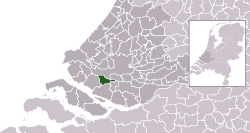Spijkenisse
Town in South Holland, Netherlands From Wikipedia, the free encyclopedia
Town in South Holland, Netherlands From Wikipedia, the free encyclopedia
Spijkenisse (Dutch pronunciation: [spɛikəˈnɪsə] ) is a large town in the province of South Holland, Netherlands. Following an administrative reform in 2015, it is part of the municipality of Nissewaard, and has a population of 72,500. It covers an area of 30.27 km2 (11.69 sq mi) of which 4.15 km2 (1.60 sq mi) is water. It is part of the Greater Rotterdam area.
Spijkenisse | |
|---|---|
 Town centre of Spijkenisse | |
 Location in South Holland | |
| Coordinates: 51°51′N 4°20′E | |
| Country | Netherlands |
| Province | South Holland |
| Municipality | Nissewaard |
| Area | |
| • Total | 30.27 km2 (11.69 sq mi) |
| • Land | 26.12 km2 (10.08 sq mi) |
| • Water | 4.15 km2 (1.60 sq mi) |
| Elevation | −1 m (−3 ft) |
| Population | |
| • Total | 72,500 |
| Demonym | Spijkenissenaar |
| Time zone | UTC+1 (CET) |
| • Summer (DST) | UTC+2 (CEST) |
| Postcode | 3200–3209 |
| Area code | 0181 |
| Website | www |

Archaeological evidence suggests that the area around Spijkenisse has been inhabited for several thousand years. The area's prehistoric inhabitants depended on fishing in the Maas and hunting in the surrounding swamps for sustenance.
The oldest known reference to the name Spickenisse is in a source from 1231. Spijkenisse is a portmanteau of the words spieke (spit) and nesse (nose) meaning "pointy nose." The name is a reference to the settlement's location on a spit of land protruding into the river.[3]
Spijkenisse formed as a farming and fishing village on a creek along the Oude Maas. It originally belonged to the Lord of Putten (whose coat of arms is now used by the town) but in 1459 the fiefdom of Putten, including Spijkenisse, was transferred to Philip III, Duke of Burgundy. In 1581, after the Dutch declaration of independence, the area came under the control of the States of Holland and West Friesland.[4]
In the 16th century, the village suffered several floods, and endured destructive fires in the following two centuries which hampered its economic growth. In the 20th century Spijkenisse heavily urbanised as part of the Greater Rotterdam area. Contemporary Spijkenisse includes the communities of Hekelingen, Den Hoek, and Beerenplaat.
Spijkenisse has a connection to the city of Rotterdam by Rotterdam Metro lines C and D, through Spijkenisse Centrum, Heemraadlaan and De Akkers stations. The metro is operated by RET.
On 2 November 2020, at about 00:30, a train ran through buffers at the end of the line and was saved from plunging 10 metres by the "Whale tails" sculpture.
There are also several bus services operated by EBS and 1 line of Connexxion to Ouddorp.
In 2011, the town built seven bridges designed by Robin Stam, replicating Robert Kalina's fictional designs on the euro banknotes.[5][6][7][8]
| Roman Catholic | Protestant | Public | Calvinist |
|---|---|---|---|
| De Akkers | Het Anker | Annie MG Schmidt | De Morgenster |
| De Klinker | Het Baken | De Vuurvogel | |
| De Maasoever | De Bron | ||
| Monseigneur Bekkersschool | De Duif | De Vogelenzang | |
| De Wegwijzer | De Hoeksteen | De Krullevaar | |
| Paus Johannes | De Marimba | De Meander(tot 2012) | |
| De Rank | De Montessori | ||
| De Schakel | Jan Campert | ||
| De Piramide | |||
| De Toermalijn | |||
| De Veenvlinder |
| Roman Catholic | Christian | Public |
|---|---|---|
| MAVO Charles de Foucauld | PENTA college CSG Scala Molenwatering | OSG My College |
| PENTA College CSG Scala Rietvelden | OSG De Ring van Putten | |
| PENTA college CSG De Oude Maas |

Spijkenisse is twinned with the following cities:
|
Seamless Wikipedia browsing. On steroids.
Every time you click a link to Wikipedia, Wiktionary or Wikiquote in your browser's search results, it will show the modern Wikiwand interface.
Wikiwand extension is a five stars, simple, with minimum permission required to keep your browsing private, safe and transparent.